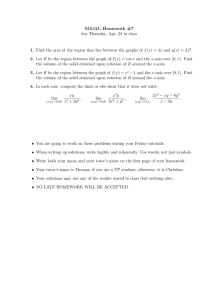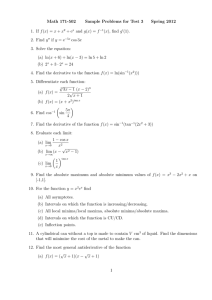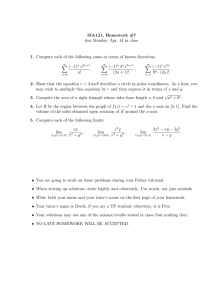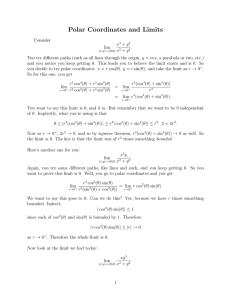MA121, Homework #7 Solutions x
advertisement
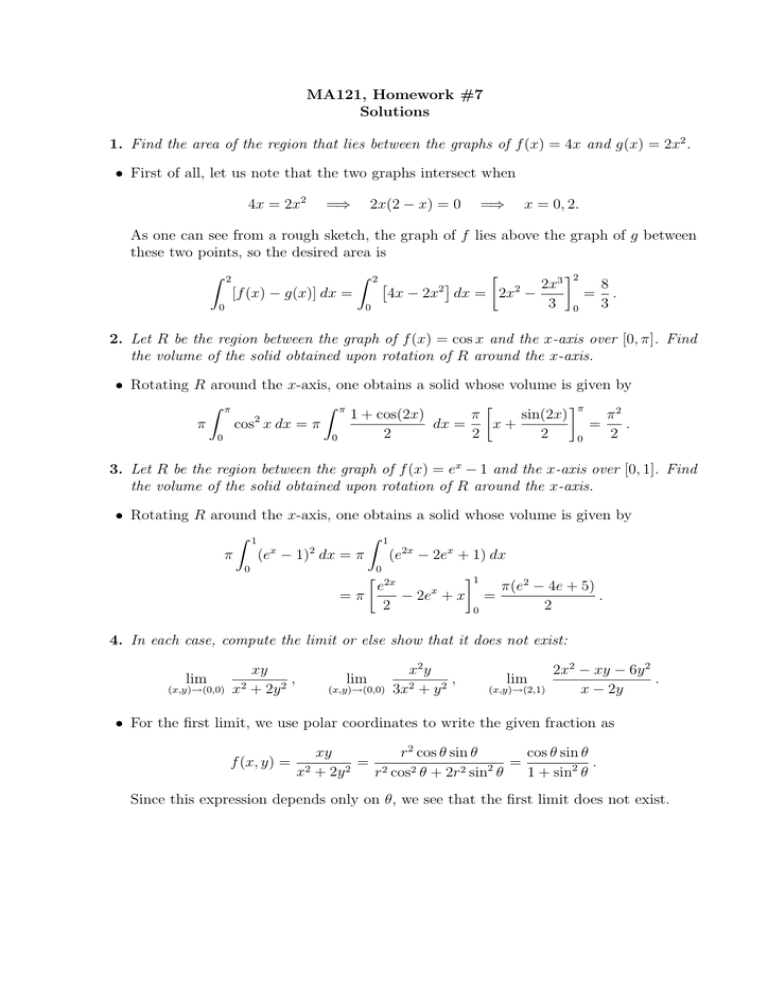
MA121, Homework #7 Solutions 1. Find the area of the region that lies between the graphs of f (x) = 4x and g(x) = 2x2 . • First of all, let us note that the two graphs intersect when 4x = 2x2 =⇒ 2x(2 − x) = 0 =⇒ x = 0, 2. As one can see from a rough sketch, the graph of f lies above the graph of g between these two points, so the desired area is Z Z 2 2 [f (x) − g(x)] dx = 0 £ 0 ¤ · 2x3 4x − 2x dx = 2x − 3 2 ¸2 2 = 0 8 . 3 2. Let R be the region between the graph of f (x) = cos x and the x-axis over [0, π]. Find the volume of the solid obtained upon rotation of R around the x-axis. • Rotating R around the x-axis, one obtains a solid whose volume is given by · ¸π Z π Z π π2 1 + cos(2x) π sin(2x) 2 = π cos x dx = π dx = x+ . 2 2 2 2 0 0 0 3. Let R be the region between the graph of f (x) = ex − 1 and the x-axis over [0, 1]. Find the volume of the solid obtained upon rotation of R around the x-axis. • Rotating R around the x-axis, one obtains a solid whose volume is given by Z 1 Z 1 x 2 π (e − 1) dx = π (e2x − 2ex + 1) dx 0 0 · 2x ¸1 e π(e2 − 4e + 5) x =π − 2e + x = . 2 2 0 4. In each case, compute the limit or else show that it does not exist: lim (x,y)→(0,0) xy , x2 + 2y 2 lim (x,y)→(0,0) x2 y , 3x2 + y 2 lim (x,y)→(2,1) 2x2 − xy − 6y 2 . x − 2y • For the first limit, we use polar coordinates to write the given fraction as f (x, y) = r2 cos θ sin θ cos θ sin θ xy = = . 2 2 2 2 2 2 x + 2y r cos θ + 2r sin θ 1 + sin2 θ Since this expression depends only on θ, we see that the first limit does not exist. • For the second limit, we use polar coordinates to similarly write r3 cos2 θ sin θ r cos2 θ sin θ x2 y = = . 3x2 + y 2 2 cos2 θ + 1 3r2 cos2 θ + r2 sin2 θ p Since (x, y) approaches the origin, we have r = x2 + y 2 → 0, so the given function must approach zero as well. More precisely, we have f (x, y) = 0 ≤ |f (x, y)| ≤ |r cos2 θ sin θ| ≤ r and the fact that r → 0 implies that f (x, y) → 0 because of the Squeeze Law. • Using division of polynomials to compute the last limit, one finds that lim (x,y)→(2,1) 2x2 − xy − 6y 2 = lim (2x + 3y) = 4 + 3 = 7 (x,y)→(2,1) x − 2y because the linear function g(x, y) = 2x + 3y is known to be continuous.

